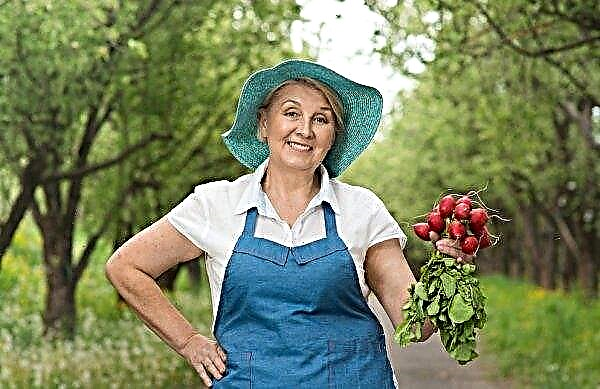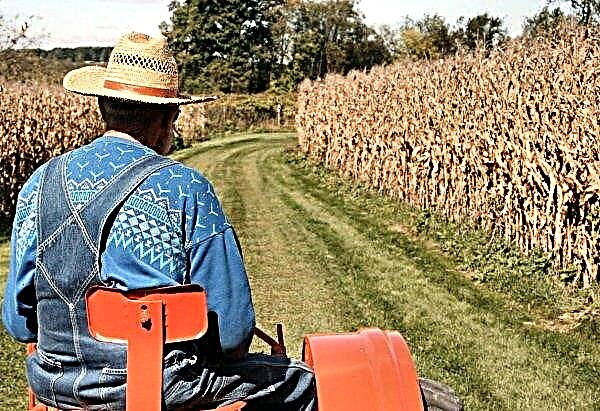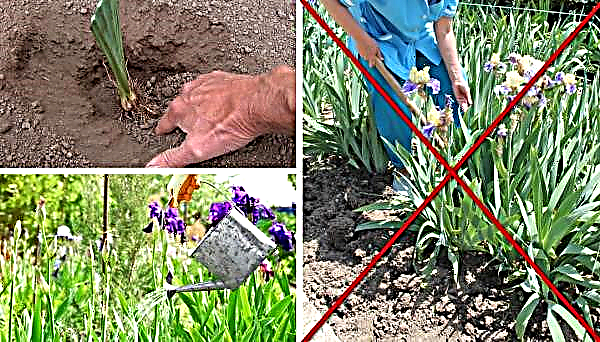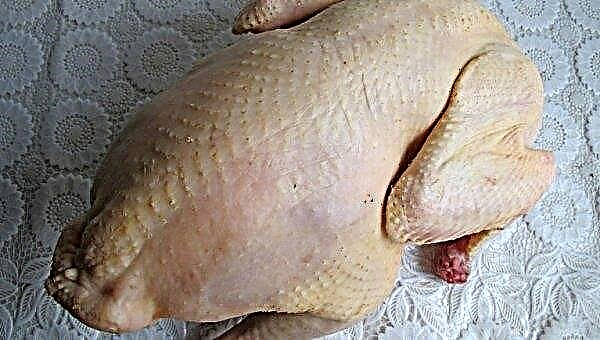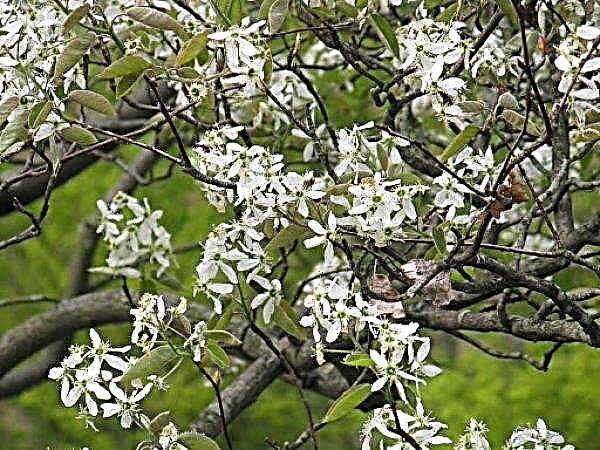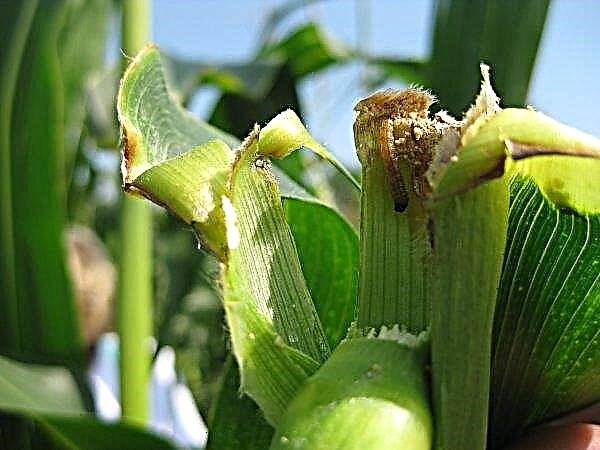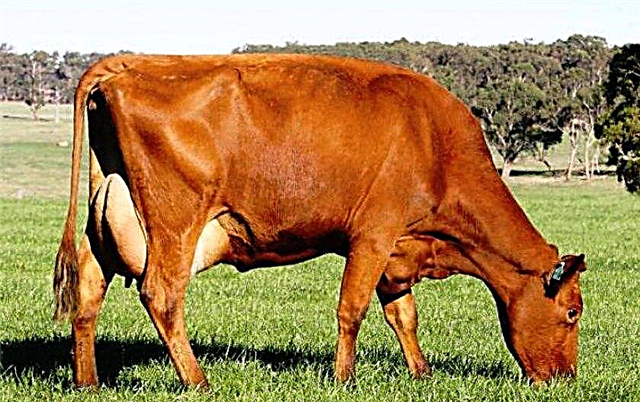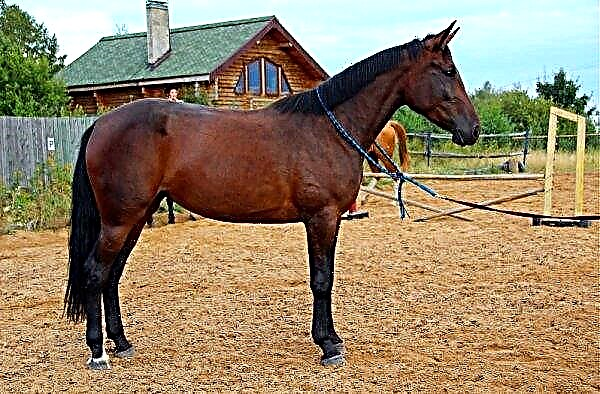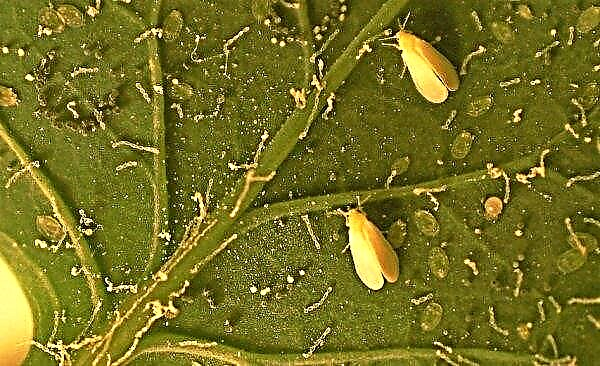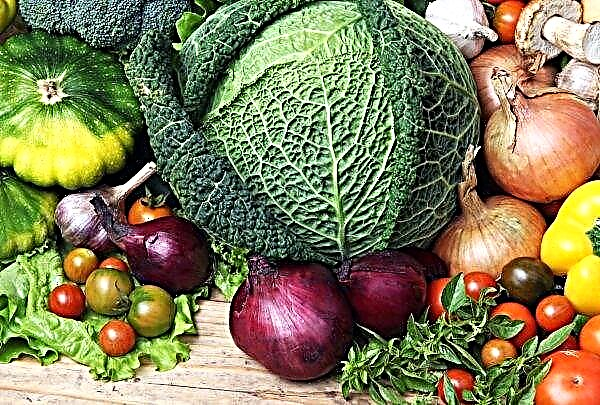Special merchandise and gustatory qualities are distinguished by Champion Jane apples. Trees tolerate drought well and are relatively unpretentious in care. Read more about the variety and the rules for its cultivation, read below.
Description of apple variety Champion
The culture was bred by Czech breeders of the Experimental Station in Golovous in 1970. Golden Delishes and Renet Orange Cox acted as parent plants. The new variety harmoniously combines the best genetic data of parental specimens, thanks to which it quickly gained popularity around the world.
Did you know? The world's oldest apple tree was planted 380 years ago in the vicinity of New York. The most interesting thing is that it still bears fruit.
A little later, the Poles tried to repeat the experience of the Czechs. In 1992, Champion Arno and Champion Renault were bred on the basis of this variety.
Trees of the species in question without pruning grow up to 5 m. Plant formation is well tolerated, so usually the growth point is stopped. The crown is compact, oval in shape with medium leafiness. Strong shoot growth is observed during the first 3 years after planting. From the moment of fruiting, growth decreases.
Also, there is a slowdown in the development of the tree in highly productive years. The skeleton is moderately developed. The main conductors are located in relation to the trunk at an angle of 50–70 °. Fruiting is mixed, i.e., ovaries form both on old branches and on annual growths.
 Flowering begins in early May in the southern regions, in late May - early June in regions with a temperate climate and more northern. Pollen viability is medium or above average - in the range from 32 to 60%.
Flowering begins in early May in the southern regions, in late May - early June in regions with a temperate climate and more northern. Pollen viability is medium or above average - in the range from 32 to 60%.
Plants bear fruiting phase for 3 years from the moment of planting. The maximum peak yield is reached for 5 years and stored in the future. The exact life span of specimens of this variety has not been studied, because the variety is young enough to compare with a standard of 100 years.
Regarding frost resistance, it shows average indicators. It tolerates winters in the middle lane in the presence of high-quality shelter. In the northern regions does not take root. The variety is characterized by medium scab tolerance and high mildew. It may undergo a bitter pitting of the fetus in the absence of high-quality nutrition.
Winter varieties of apple trees also include:
Fruit Characteristics
The weight of Champion apples varies from 140–210 g. The fruits are distinguished by attractive external characteristics and taste. They are aligned, have the correct rounded shape. The period of removable maturity reaches in the second decade of September - October, depending on the region of cultivation.
The skin is thin. Its main color is yellow-green, integumentary - red. Blush is located on almost the entire surface of the fetus. The pulp is white, very tender in structure, fine-grained, juicy. The taste of fruits is sweet with sourness. The fruits of the Champion cultivar are technologically ripe when they ripen, especially on old trees, and the entire crop can “fall to the ground” in two days
The fruits of the Champion cultivar are technologically ripe when they ripen, especially on old trees, and the entire crop can “fall to the ground” in two days
Apples of this variety are grown primarily for fresh use, but they are also good in processing. The consumer period begins 2 weeks after the harvest. With proper storage, the fruits retain their qualities for 5 months. Transportability of the crop is not high - during transportation, high-quality packaging is necessary, because apples are not resistant to mechanical damage.
Video: Champion apple variety
Pros and cons of the variety
- The main advantages of the variety:
- stable regular productivity without downtime;
- high commercial and taste qualities of apples;
- good keeping quality of fruits;
- early maturity of the plant;
- resistance to scab, mildew and drought;
- compact crown.
- Of the minuses emit:
- average frost resistance;
- susceptibility to bitter fruiting;
- partial autonomy.
Did you know? An adult tree consists of 99% of dead cells and only 1% falls on the functional part, which is responsible for photosynthesis and juice movement.
Pollinating varieties
The champion is among the partially self-fertile varieties. With free pollination, 31% of the fruits are tied in a tree. Pollinators are needed to increase fruitfulness. In this quality, the varieties are best suited:
- Florin;
- Idared
- James Greve
- Pilot;
- Pinova.

Productivity
At the age of three, the plant brings about 10 kg of apples. Over the years, productivity increases and by the age of 5 is from 20 to 25 kg.
Planting and caring for an apple champion
With great care, you need to approach the creation of optimal conditions for the development of a tree:
- lighting - the site should be sunny, it is best to give preference to the south, southeast or southwest side;
- windiness - the place on the north side should be protected from the wind, the tree does not grow well in drafts;
- soil quality - acidity in the range of 5–7 pH, good friability and nutrition, loams and sandstones well fertilized with organic matter are best suited;
- groundwater distance - not less than 2 m.
1-2 year old seedlings have the best survival rate. When buying them, you need to pay attention to the condition of the stem and the root system. In healthy specimens, the trunk is aligned, the roots are at least 30 cm long, including several main and many additional ones. The height of the stem is from 1.2 to 1.5 m. In one-year-olds, the trunk is bare, in two-year-olds there are about 5 skeletal branches. In addition, at a distance of 5 cm from the central root there should be a place of budding. In healthy, full-fledged plants, it looks like a slight bend with a healed wound surface from a cut rootstock.
Planting of apple trees is best done at the end of April, when there is no longer a risk of return frosts. In the fall, plants are planted that are more than 3 years old at the time of purchase. But, such a purchase is impractical, because plants of this age have a lower survival rate.
Soil preparation on the site begins in advance, in the fall. The soil is carefully dug to a depth of at least 30 cm. After this, the soil is irrigated with a disinfectant. To do this, use a 3% solution of copper sulfate or Fitosporin diluted 5:10. After a week, 20 kg of fresh manure and 300 g of superphosphate per 1 m² are added. If the soil is heavy, then in combination with fertilizers, 10 kg of peat and sand are applied to each m². Then the soil is again cultivated to a depth of 30 cm. With increased soil acidity, instead of manure, compost is added in an amount of 20 kg / m² + 300 g of dolomite flour or 500 g of wood ash.
Did you know? Trees from the atmosphere absorb food 10 times more than from the ground.
A month before planting, the site again conducts aeration work and brings in 20 kg of compost for each m². A week before planting, they begin to prepare the holes. The distance between them is left within 1.5 m, and in rows not less than 4 m. The depth of the pit is 60–70 cm, depending on the size of the root, and the width is 1 m. The upper 30 cm of soil from the pit is folded separately. Then it is mixed with 10 kg of compost, rotting manure and peat. To this mixture was added 300 g of superphosphate. With the resulting composition, fill the pit by 1/3, set in the center of the stake and pour 20 liters of water.
 For better development and fruiting, do not plant trees in places where old ones were
For better development and fruiting, do not plant trees in places where old ones were
4 hours before planting, preparatory manipulations with seedlings begin:
- The roots are carefully inspected and the dried parts are cut so that there is a white area on the cut.
- Then soaked for 2 hours in a solution of Fitosporin. A bag of powder preparation (10 g) is added to 5 l of water.
 The root neck should protrude 3-5 cm above the soil surface. A column for garter trees is installed in the pit during planting to avoid further damage to the roots
The root neck should protrude 3-5 cm above the soil surface. A column for garter trees is installed in the pit during planting to avoid further damage to the roots
Features of caring for a variety of apple trees
When growing an apple tree, the main task of the agrarian is to pay sufficient attention to the implementation of agrotechnical measures in accordance with the phases of the plant’s vegetation.
Plant care includes the following seasonal activities:
- watering and top dressing;
- pruning
- whitewash the trunk;
- preparation for wintering;
- preventive measures.
Video: How to properly care for fruit trees
Watering and feeding
In the first year after planting, the tree requires frequent hydration. Young trees contribute 20-30 liters of water at a time. Watering is carried out once every 1-2 weeks, depending on the weather. From the second year of life, the plants on the site switch to the moistening mode once a month and add 50 l of water each. Instances from 3 to 5 years of age require about 70 liters per m² of barreled circle once every 2 months. Older trees are watered according to the schedule:
- before swelling of the kidneys;
- after flowering;
- in the middle of July;
- after harvesting.
The frequency of watering depends on the weather. In a too dry climate, you can increase their number up to 1 time in 2 months.
Important! After each moistening, it is necessary to carry out loosening of the soil and mulching with a layer of compost of 5 cm.
Fertilizing begins to make from 3 years of life of the plant on the site. Up to this point, the tree has enough food made at the preparatory stages. Fertilize according to the scheme:
- in the spring before the swelling of the kidneys - 6 tbsp. l urea per 30 liters of water or 5 liters of liquid mullein per 30 liters of water;
- after flowering - 30 g of potassium sulfate and superphosphate;
- one month before harvest - 1 kg of ash per 5 l of water is insisted for 5 days, then 10 l of water are filtered out and sprayed on the sheet and irrigated;
- after harvest - 90 g of superphosphate per 30 l of water.
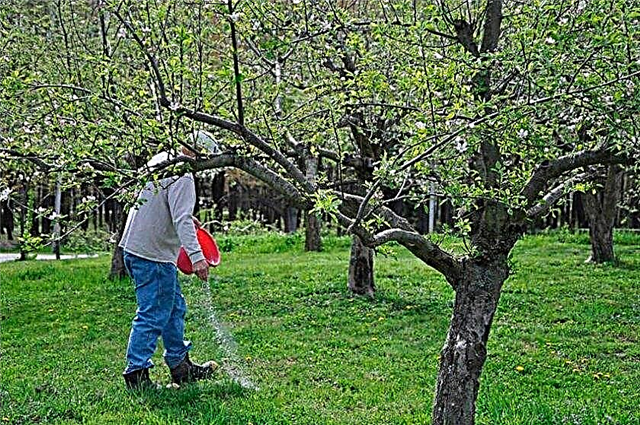
Cropping and shaping crowns
Pruning begins one year after planting. At this stage, 5 powerful skeletal branches of the first order are left. They are shortened to 30 cm. The main conductor is shortened so that it is 20 cm longer than skeletal branches. All shoots growing on the trunk, lower than 50 cm from the ground level, are completely removed. Sections must be dusted with ash or powdered activated carbon, then sealed with garden var.
The following year, they conduct the formation of the second row of skeletal conductors. On the shoots of the first order leave 2-3 annual growth. They are shortened to 15 cm. Also at this stage, all branches competing to the main are cut. In the third year, the formation of shoots of the 3rd order is carried out in a similar way.
In the future, the crown is maintained in this form by sanitary scraps. Annually, branches thickening the stems damaged during the winter or mechanically are removed.
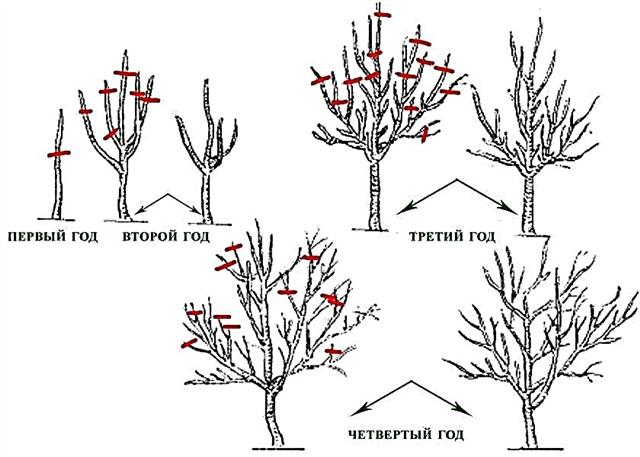
Whitewash
In autumn and spring, the trunk must be whitened to a height of 1 m from the ground level. Young trees also capture 10 cm of skeletal shoots. This manipulation helps protect plants from fungal diseases and pests.
Winter preparations
Champion apple trees need careful preparation for the winter. In late September - early October, after carrying out all the above agricultural practices, the trunk circle is mulched with a layer of compost 10 cm high. The trunk is wrapped with burlap or agrofibre. Trees under 5 years old, grown in temperate climates, will need winding not only the trunk, but also skeletal branches.
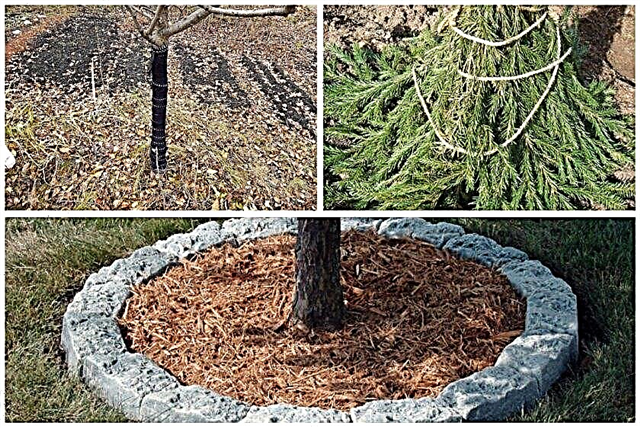
Diseases and Pests
The variety in question can be affected by the following diseases:
- Bacterial burn - the disease is treated with antimicrobial agents. Ampicillin ampoule (you can take any other antibiotic from the penicillin series) is diluted in 10 liters of water and sprayed with plants, as well as the soil around them every 20 days. If the disease progresses, and the treatment does not work, the apple tree should be uprooted.
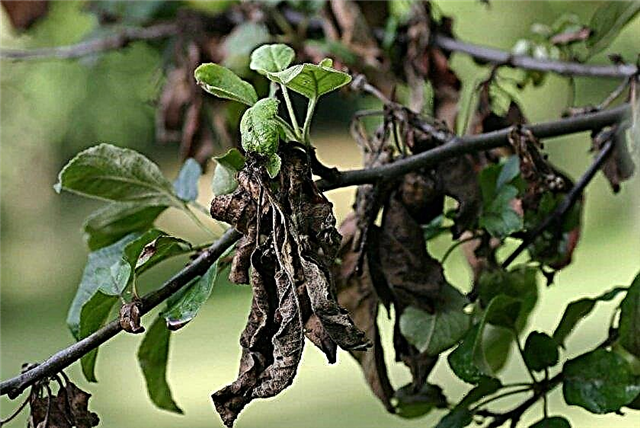
- Bitter dimple - manifests itself as depressed spots of yellow or reddish color on the fruits. On the palate, such fruits become bitter. To avoid this disease, after flowering every 20 days, a 0.4% solution of calcium chloride is sprayed. The last time the treatment is carried out a month before harvesting.
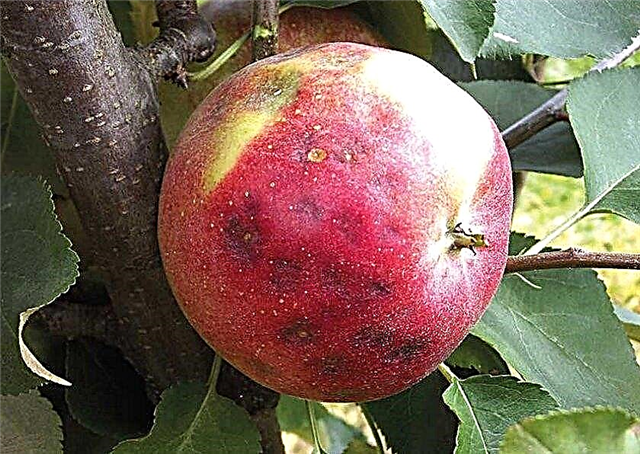
- Rust - when the first symptoms appear, the plants are sprayed with 1% solution of copper sulfate. In spring and autumn, use 3% concentrate.
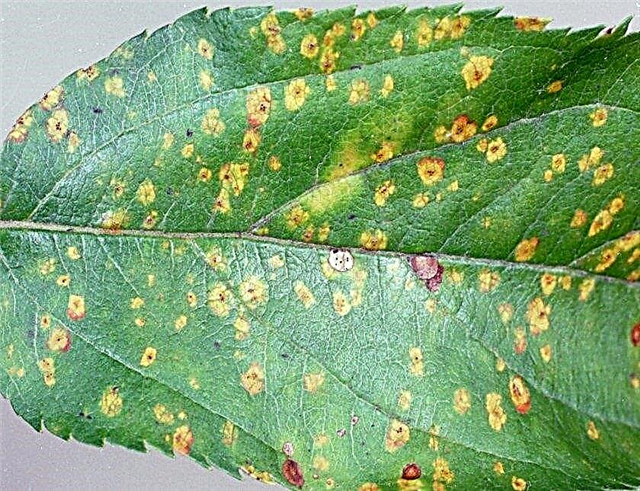
Among the pests for the apple tree, the Champion is dangerous only to the moth. To get rid of it, dusting of plants and the soil around them is carried out with tobacco dust. It is advisable to carry out 2 treatments with an interval of 14 days. Instead of tobacco dust, you can use wood ash.
Important! After harvesting, be sure to destroy the fallen leaves and fruits - in them pests and fungal spores can remain viable throughout the winter.
For preventive purposes, in autumn, after harvesting, plants and soil are sprayed with 3% solution of copper sulfate. In the spring, Phytosporin diluted 5:10 is used for these purposes. An important preventive measure is digging the soil in the near-stem circle in autumn and spring, to a depth of 15 cm. Mulching the soil after rainfall and watering helps protect against the spread of diseases and pests..
Video: Why and how to mulch the soil correctly
Harvesting and storage
Apples are removed from the branches along with the stalks. Immediately sort and lay out the products in wooden or plastic boxes in one layer. If you need to transport apples, then each wrapped in soft paper.
Store the crop at a temperature of +3 ... + 6 ° C and a relative humidity of 70% in a place protected from sunlight. Only under such conditions will it be possible to maintain the quality of the fruit for 5 months. At room temperature, the fruits are stored for no longer than 1 month. Champion does not require additional devices and efforts to assemble apples, the leg of the ripened fruit breaks off with a light touch
Champion does not require additional devices and efforts to assemble apples, the leg of the ripened fruit breaks off with a light touch
Champion apple-tree is of good quality. In care, the tree is relatively not whimsical, but requires high-quality preparation for the winter, which should be taken into account when cultivating.
Network user reviews
ADVANTAGES: delicious, sweet
DISADVANTAGES: no
Hello everyone and all the best! We are all familiar with fruits like apples. These are the most common and popular fruits in our country. During its flowering, apple trees are very pleasing to us with delicate, varied shades of flowers. The fruits themselves, we eat fresh and cook a variety of foods from them. There are a lot of apple varieties. They differ in taste, color, and consistency of the fruit. Today I bought fresh Champion apples. Apples of this variety are quite large, their shape is slightly oval. One apple can weigh up to two hundred grams. The peel of these apples is thin, but at the same time strong and elastic. A fully ripened fruit has a red-orange blush. The flesh of these apples is very juicy and aromatic with a delicate cream color. Their taste is sweet with a slight acidity. We love this variety of apples for the great taste of the fruit, and eat it with great pleasure. They also make delicious fresh juice. I like to add these apples to compote, pastries, pancakes, make jam out of them. My rating for these apples is five. I recommend trying them. I think you will like it.




